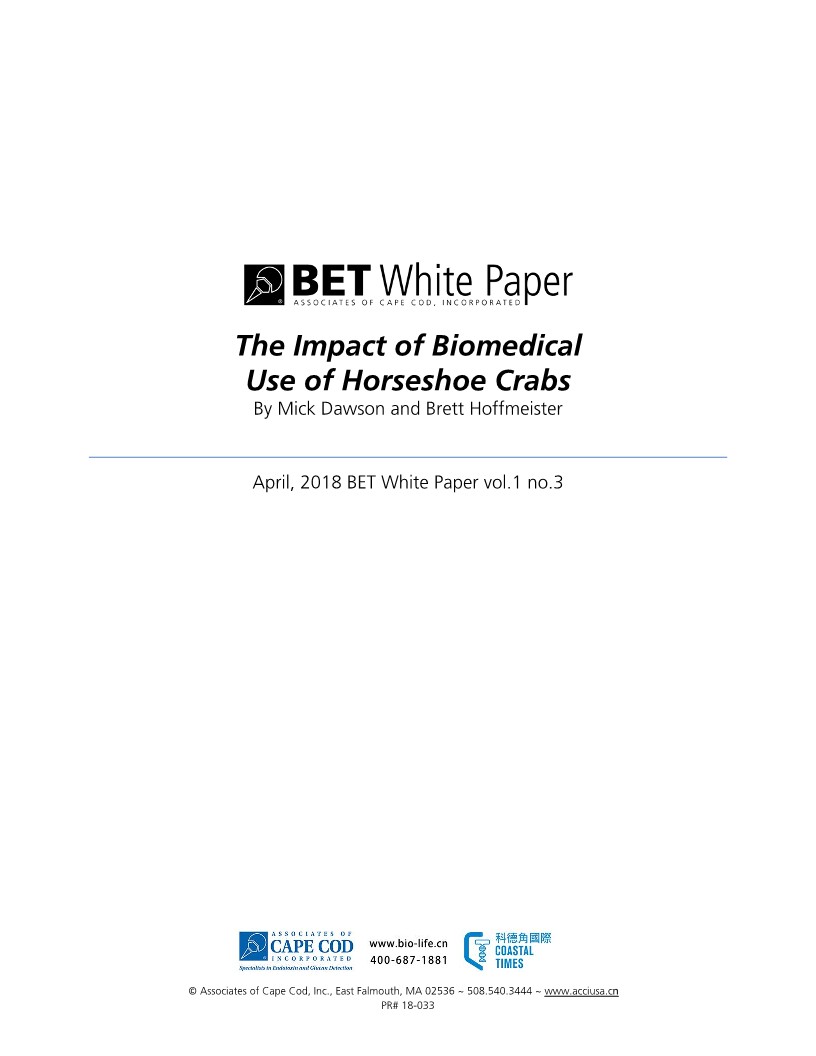The Impact of Biomedical Use of Horseshoe Crabs - By Mick Dawson and Brett Hoffmeister
- 分类:文献资讯
- 作者:By Mick Dawson and Brett Hoffmeister
- 来源:科德角国际
- 发布时间:2023-03-28 14:54
- 访问量:
【概要描述】The Impact of Biomedical Use of Horseshoe Crabs - By Mick Dawson and Brett Hoffmeister
The Impact of Biomedical Use of Horseshoe Crabs - By Mick Dawson and Brett Hoffmeister
【概要描述】The Impact of Biomedical Use of Horseshoe Crabs - By Mick Dawson and Brett Hoffmeister
- 分类:文献资讯
- 作者:By Mick Dawson and Brett Hoffmeister
- 来源:科德角国际
- 发布时间:2023-03-28 14:54
- 访问量:

rts contained information that is inaccurate regarding the horseshoe crab population and its use in the biomedical industry. This article is to clarify some of the misleading suggestions made in those publications. It has been suggested that biomedical manufacturers of Limulus Amebocyte lysate (LAL) reagents are a primary contributor to a speculative population decline of the American horseshoe crab, Limulus polyphemusi, ii. There are two components to this assertion: first,
the American horseshoe crab population is in danger and second, the manufacturers of LAL are a primary cause of horseshoe crab mortality.
This article shows that the overall number of horseshoe crabs is stable; L. polyphemus is certainly not in danger of extinction and that the biomedical industry has a relatively minor impact on mortality in the horseshoe crab population.
Is the horseshoe crab population in the United States in danger?
The simple answer is that the total number of horseshoe crabs is healthy, stable, and may be increasing. There is reliable data concerning horseshoe crab population numbers and trends for roughly 20 years, and analysis of that data shows no evidence of an overall decline over that time. The American horseshoe crab has a widespread distribution made up of multiple populations along the east coast of the United States, so a more thorough analysis is necessary to determine the health of the metapopulation.
The largest population of horseshoe crabs on the east coast is in Delaware Bay, and the most recent data show that numbers there are stable and/or increasing. A summary of an October 5, 2016 meeting of the Atlantic States Marine Fisheries Commission (ASMFC) Horseshoe Crab Technical Committeeiii includes estimates for horseshoe crabs in the Delaware Bay from 2015. The collected data indicated the presence of approximately 8.1 million females and 16.4 million males, which is an increase from 7.9 million females and 15.2 million males in 2014. Data from the state of New Jersey portion of Delaware Bay reveal that numbers of female, male, and juvenile horseshoe crabs are variable, but the population has shown an upward trend since the early 2000s. In the New Jersey Ocean survey (outside the Delaware Bay), the indices for both adult female and male horseshoe crabs showed a slight increase in 2015. Data for the Maryland shore, south of the Delaware Bay, also show a positive trend since 2008, and the 2015 spawning survey showed a slight increase compared to the previous year. There are no recent survey data for states south of Maryland but the last stock assessment report from the ASMFCiv which included data up to 2012, indicated that in the Southeast
abundance had remained stable or continued to increase since the 2009 stock assessment.
In the Northeast region, populations are smaller than further south. Variations in subpopulation sizes do not have a huge impact on the metapopulation; however, variations may be important locally. Out of sixteen surveys performed annually in New York, only one survey consistently shows declines. Connecticut reported that numbers of horseshoe crabs in central and western Long Island Sound are stable, but have declined rapidly in the eastern region. In Rhode Island, the abundance indices and the spawning survey show that the population is at a low level.
In Massachusetts, the most recent Compliance Report by the Massachusetts Division of Marine Fisheries (MADMF) for the ASMFC states that the 2016 trawl surveys exhibited horseshoe crab abundance exceeding median levels, continuing an upward trend following reports from two years priorv. It is reported that there are more horseshoe crabs present in the southern region of Massachusetts state waters than in the 40 year surveying history.
The American horseshoe crab has distinct, fragmented subpopulations all over the eastern seaboard, including states north of Massachusetts. These northern fisheries are so small that these states are not required to report population trends to the ASMFC. Georgia and Florida both have horseshoe crab populations that appear to be stable.
Is the biomedical fishery a significant contributor to horseshoe crab mortality?
The process of extracting the blood from the horseshoe crabs is minimally invasive and the overwhelming majority of crabs that undergo the procedure survive the process. The biomedical community supports and practices a release program where crabs caught under a biomedical license are released back to the wild. The Atlantic States Marine Fishery Commission (ASMFC), which manages the horseshoe crabs along the entire east coast, attributes 15% mortality to those released crabsvi, assuming an 85% survival rate. Coast
wide, an average of 493,091 (Fig. 1) crabs are caught and released annually for use in the manufacture of LAL.
Horseshoe crabs are also used as bait in the whelk and eel fisheries in the US and abroad. Horseshoe crabs are harvested and placed in traps where the eels or conch enter but cannot easily exit. This process is fatal to the crabs and has come under significant scrutiny coast wide with several states choosing to prohibit the practice altogether. In states that do allow a bait harvest, measures such as minimum sizes, a male only harvest and/or prohibitions around harvest timing help to protect spawning stock. Coast wide from Maine to Florida, a six year average of 715,000 (Fig. 1) crabs is caught annually to be used for bait. All states which have a significant harvest of crabs for use in the bait and/or biomedical industry are required by law to report information regarding the number and sex of crabs harvested to the ASMFC.
The coast wide horseshoe crab mortality is represented in the graphs below. It can be seen that the biomedical industry does not substantially contribute to overall mortality (Fig. 2). Additionally, the management of the fishery by the ASMFC and state fishery departments has ensured that the use of the horseshoe crabs in both bait and biomedical industries is closely monitored.
Figure 1 Figure 2
To further evaluate if areas of biomedical catch and release are impacting horseshoe crab populations, an analysis of areas with biomedical manufacturers is explained below.
Horseshoe crabs are collected for biomedical purposes in the Delaware Bay and in the coastal waters of South Carolina, and population numbers in all of these areas are either stable or increasing. In New York, where there is no reported biomedical fishery, one of the sixteen sites surveyed shows declining numbers. In Connecticut, where there is no biomedical crab fishery, populations have declined in the eastern region. In Rhode Island, where there is a limited bait fishery and limited biomedical fishery, recent numbers are low, but data gave no indication of an increasing or decreasing trend. In Massachusetts, where there is a biomedical fishery and a bait fishery, survey data show positive population trends, particularly in the southern region where the fisheries are concentrated. In a 2017 memorandum that addresses the status of horseshoe crab populations in the state, the director of the MADMFvii states “We have found horseshoe crabs are supporting a stable
fishery and appear to be increasing in abundance” and “the size of male and female crabs measured as part of our market sampling program has been consistent. There is no indication that harvesting for biomedical purposes has truncated the horseshoe crab population’s size structure”.
A decrease in size would be a classic indication that a population is being overfished; therefore this statement given by the MADMF director is an important distinction when considering the health of the Massachusetts’ horseshoe crab population. In summary, these reports give no indication of a correlation between the biomedical fishery and population decline. In the regions with the largest biomedical fisheries, numbers are stable or even increasing.
Recent articles have also suggested that the handling of the horseshoe crabs results in a higher mortality than is estimated by the ASMFC. In some experimental studies focused on the after effects of the biomedical use on horseshoe crabsviii,ix,x, crabs were handled and kept under sometimes more
stressful conditions than those used by the biomedical community. This resulted in reports of high mortality and sub-lethal effects. In one study, no mortality occurred for crabs handled under conditions of low stress, whereas up to 29% mortality occurred in the highly stressed group. Like all animals, if horseshoe crabs are not treated well, they do not fare well. Proper handling of horseshoe crabs is important to maximize the survival of horseshoe crabs returned to the water. This is recognized by the ASMFC, who manages the horseshoe crab fishery according to a fishery management plan (FMP)xi. A code
of best management practices has been formulated between the ASMFC, the states, and biomedical companies, which builds on the catch and release practices that have been in place for many yearsxii. In Massachusetts, there is a
regulatory requirement to adhere to specific best practices as a condition of the biomedical license.
Summary
In conclusion, the overall population of horseshoe crabs is stable and/or increasing. The management of horseshoe crabs is highly regulated in the United States on both a regional and state specific level. The population successfully supports both a bait industry as well as a biomedical industry. Given these facts it is clear that the biomedical use of horseshoe crabs does not have a significant adverse impact on horseshoe crab populations.
References
i Chesler, C. Medical Labs May Be Killing Horseshoe Crabs, Scientific American,
June 9, 2016 https://www.scientificamerican.com/article/medical-labs-may-be-
killing-horseshoe-crabs/?WT.mc_id=SA_FB_ENGYSUS_NEWS.
Accessed December 6, 2017.
ii Johnson, C. Y. Is the Biotechnology Industry Contributing to the Horseshoe crab’s Decline? Boston Globe, March 3, 2014
https://www.boston.com/news/science/2014/03/03/is-the-biotechnology-industry- contributing-to-the-horseshoe-crabs-decline. December 6, 2017.
iii ASMFC Horseshoe Crab and Delaware Bay Ecosystem Technical Committees Meeting, October 5, 2016.
http://www.asmfc.org/files/Meetings/2016AnnualMeeting/HorseshoeCrabBoardSup plemental.pdf. Accessed December 6, 2017.
iv 2013 Horseshoe Crab Stock Assessment Update, ASMFC Horseshoe Crab Stock Assessment Subcommittee
http://www.asmfc.org/uploads/file//52a88db82013HORSESHOE
CRABS_StockAssessmentUpdate.pdf. Accessed June 14, 2017.
v Massachusetts 2016 Compliance Report to the Atlantic States Marine Fisheries Commission – Horseshoe Crab.
https://www.mass.gov/files/documents/2017/09/19/compliance%20report%202016 %20public_0.pdf. Accessed December 6, 2017.
vi 2016 Review of the Atlantic States Marine Fisheries Commission Fishery Management Plan for Horseshoe Crab (Limulus polyphemus) 2015 Fishing Year, http://www.asmfc.org/uploads/file/58b70d1eHORSESHOE
CRABS_FMPReview_2016.pdf, Accessed March 8, 2017.
vii Massachusetts Division of Marine Fisheries, Memorandum of October 13, 2017, from David E. Pierce, Director, to AJ Meuse, President, Associates of Cape Cod, Inc. re. Status of horseshoe crabs in Massachusetts
viii Anderson RL, Watson WH 3rd, Chabot CC. Sublethal behavioral and physiological effects of the biomedical bleeding process on the American horseshoe crab, Limulus polyphemus. Biol Bull. 2013; 225(3):137-51.
https://www.ncbi.nlm.nih.gov/pubmed/24445440. Accessed December 6, 2017. ix Hurton L, Berkson J. Potential causers of mortality for horseshoe crabs (Limulus
polyphemus) during the biomedical bleeding process. Fish. Bull. 2006; 104:293– 298.
https://vtechworks.lib.vt.edu/bitstream/handle/10919/48012/hurton.pdf?sequence= 1&isAllowed=y. Accessed December 6, 2017.
x Leschen AS, Correia SJ. Mortality in female horseshoe crabs (Limulus polyphemus) from biomedical bleeding and handling: implications for fisheries management, Mar. Freshw. Behav. Physiol. 2010; 43(2):135–147.
http://www.edc.uri.edu/nrs/classes/nrs555/assets/readings_2011/leschencorreia2010 _horseshoe crabs_bled_mortality.pdf. Accessed December 6, 2017.
xi Interstate Fishery Management Plan for Horseshoe Crab, Atlantic States Marine Fisheries Commission Fisheries Commission. 1998.
http://www.asmfc.org/uploads/file/hscFMP.pdf. Accessed December 6, 2017.
xii Biomedical Best Management Practices, Horseshoe Crab Biomedical Ad-Hoc Working Group Report, October 3, 2011
http://www.asmfc.org/uploads/file/biomedAdHocWGReport_Oct2011.pdf. Accessed December 6, 2017.
扫二维码用手机看
产品推荐





底部联系方式信息(左)
400-687-1881
公司电话:010-87875910
公司邮箱:info@bio-life.cn
公司官网:www.acciusa.cn www.bio-life.cn
公司地址:北京市大兴区中关村科技园区大兴生物
医药产业基地华佗路50号院18幢(中国药谷CBP)

关注官方微信

关注手机网站





